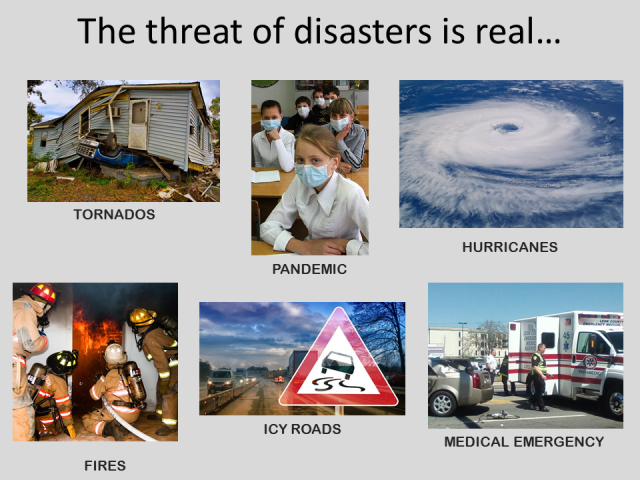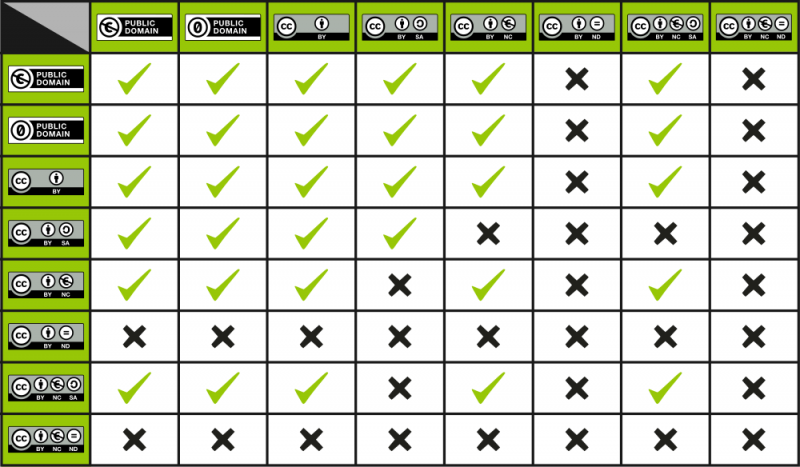Using CC Licenses and CC Licensed Works
Using CC Licenses and CC Licensed Works
Collections vs Adaptations
Collections
The distinction between Creative Commons (CC) adaptations and collections can be tricky. An adaptation, sometimes referred to as a derivative, is creating something new from a copyrighted work that is sufficiently original to itself be protected by copyright. Not all changes to a work result in the creation of an adaptation, such as spelling corrections and format shifting (e.g., from digital to print, print to audio, PDF to HTML).
In contrast to an adaptation, a collection involves the assembly of separate and independent creative works into a collective whole. A collection is not an adaption. Consider the following example of a collection of images that show possible unplanned events that could cause an interruption to course delivery. This collection assembles images to convey the need for instructional continuity plans. The images are works from various creators and are displayed individually in the collection.

Attributions: "Unplanned events" by jflorent licensed under CC BY-NC-SA 4.0 is a collection of Photo by John Middelkoop on Unsplash, “Swine flu” by Nikolay Olkhovoy used under CC BY 3.0, “Hurricane” by skeeze from Pixabay, “In the Classroom” by Oberazzi used under CC BY-NC-SA 2.0, “Wet rain skidding” by geralt from Pixabay, “Traffic Accident” by crownjewel82 used under CC BY-NC-SA 2.0.
You are required to provide attribution when you reuse CC licensed work. When you create a collection, you must provide attribution and licensing information about the individual works in your collection as shown in the above collection’s image attribution information. This gives the public the information they need to understand who created what and which license terms apply to specific content. Best practice for attribution is to provide the title, author, source, and license for the work.
When you combine material into a collection, you may have a separate copyright of your own that you may license. However, your copyright only extends to the new contributions you made to the work.
Adaptations
An adaptation/remix is a work based on one or more pre-existing works. Consider the following example of an adaption. While the images in the adapted work show a series of unplanned events, the images have been arranged in such a way that it creates a new original work.

This work, “The threat of disasters is real”, by jflorent is a derivative of “In the Classroom” by Oberazzi used under CC BY-NC-SA 2.0; “Swine flu” by Nikolay Olkhovoy used under CC BY 3.0; “Traffic Accident” by crownjewel82 used under CC BY-NC-SA 2.0; “Icy Country Road” by anitachitchat used under Pixabay License; “Traffic sign” by ZacharyOliver used under Pixabay License; Photo by John Middelkoop used under Unsplash License; and “Hurricane” by skeeze used under Pixabay License. "The threat of disasters is real" by jflorent is licensed under CC BY-NC-SA 4.0
Just like collections, adaptations also require you to provide attributions for the works you used to create the adapted work. A suggested attribution format for adapted works is “X (title) by you (author) is a derivative of Y (original work title, author, source, license) and Z (original work’s title, author, source, license)”. Refer to Best Practices for Attribution for more information on attributions.
Limitations
There are limits on whether and how you may share your adapted/remixed work.
General rules:
- If the underlying work is licensed under a NoDerivatives license, you can make and use changes privately but you cannot share your adaptation with others.
- If the underlying work is licensed under a ShareAlike license, then ShareAlike applies to your adaptation and you must license it under the same or a compatible license.
- You need to consider license compatibility. License compatibility is the term used to address the issue of which types of licensed works can be adapted into a new work.
- In all cases, you have to attribute the original work when you create an adaptation.
Adapting/remixing works with different licenses can be tricky. Use this CC License Compatibility Chart as a guide. To use the chart, find a license that applies to one of the works on the left column and the license that applies to the other work on the top right row. If there is a check mark in the box where that row and column intersect, then the works under those two licenses can be remixed. If there is an “X” in the box, then the works may not be remixed unless an exception or limitation applies.

CC License Compatibility Chart by The Sanest Mad Hatter licensed under the Creative Commons CC0 1.0 Universal Public Domain Dedication
Additionally, care should be taken when applying a CC license to your adapted work. Use this Adapters License Chart for information on applying a CC license to the adapted work.
Locating CC Licensed Works
Here are a few resources to try if you are looking for CC licensed works to use in your project:
References
Creative Commons Certificate for Educators and Librarians course
Unit 4.3 Finding and Reusing CC-Licensed Work
Creative Commons Certificate for Educators and Librarians course
Unit 4.4 Remixing CC-Licensed Work
Best Practices for Attribution
Header Image Attribution: “Using CC Licensed Works” by jflorent licensed under CC BY-SA 4.0 is a collection of Creative Commons icons used under CC BY-SA 3.0.
![]() This work, "Using CC Licenses and CC Licensed Works", by Janice Florent is licensed under a Creative Commons Attribution-NonCommercial-ShareAlike 4.0 International License, except where otherwise noted.
This work, "Using CC Licenses and CC Licensed Works", by Janice Florent is licensed under a Creative Commons Attribution-NonCommercial-ShareAlike 4.0 International License, except where otherwise noted.
